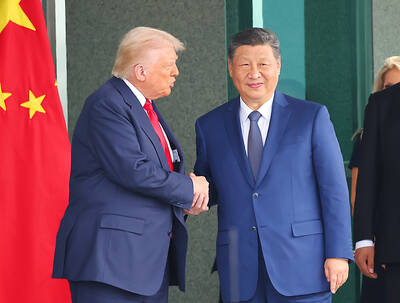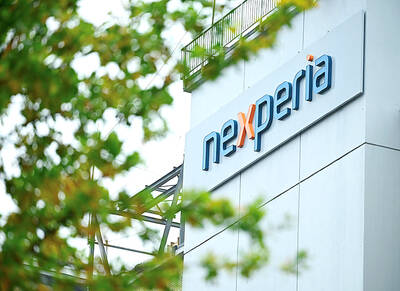China’s Yangtze Memory Technologies Co (長江存儲) has made progress in replacing foreign chipmaking technology with homegrown alternatives and its latest storage products now rival global market leaders, according to new research from TechInsights Inc.
The memory maker, one of a number of semiconductor companies subject to US trade sanctions designed to rein in China’s tech advances, is working with gear from Advanced Micro-Fabrication Equipment Inc (中微半導體), Naura Technology Group Co (北方華創) and Piotech Inc (拓荊科技), TechInsights analyst David Wei said in an interview. While the company still needs and relies on equipment from Dutch supplier ASML Holding NV and US-based Lam Research Corp, those domestic tools providers are taking up a larger share of the burden.
Trade tensions between Washington and Beijing have led to escalating export controls on advanced chips and chipmaking machinery to China, hitting companies like Yangtze Memory and Huawei Technologies Co (華為) at a time when semiconductors have grown into a strategically and economically critical sphere of business.

Photo: AFP
The Wuhan-based company recently upgraded its “Xtacking” tech, which stacks memory cells in layers, to a level where its NAND chip performance is on par with the best from industry leaders, TechInsights said in its latest research note. Demand for NAND storage has surged in recent months as the training of artificial intelligence models requires vast troves of data, and South Korea’s Samsung Electronics Co and SK Hynix Inc are the global leaders in the field.
Still, significant technical challenges remain for Yangtze Memory and its partners, which include Hwatsing Technology Co (華海清科), Wei said. The new chip made with Yangtze Memory’s Xtacking 4.0 technology actually has 70 fewer layers than the 232-layer chip made with its earlier-generation tech. This was because the latest fabrication method had a lower production yield due to the use of Chinese tools and Yangtze Memory was forced to downgrade the specification, TechInsights said.
Naura, Advanced Micro-Fabrication and Chinese peers like Piotech are all trying to improve their capabilities and catch up to US leaders like Applied Materials Inc and Lam. That effort is bolstered by having large-scale customers like Yangtze Memory, which in turn has provided memory to Shenzhen-based Huawei for its premium smartphone released in the spring, the Pura 70. At the same time, Shanghai Micro Electronics Equipment Group Co (上海微電子) is endeavoring to build advanced lithography machines like those made by ASML.
Yangtze Memory said in an email that the company is constantly improving its product performance, and the change in the layers of its latest chip is not connected with the yield rate of any particular equipment.
Currently, ASML is the only company in the world capable of making extreme ultraviolet (EUV) equipment, which is essential to produce the most cutting-edge chips.
China has yet to demonstrate an ability to manufacture advanced chips at scale without recourse to foreign-made equipment, and its lack of an EUV system could prove an insurmountable challenge. However, the country may celebrate advances like those by Yangtze Memory as evidence of progress in the nationwide push toward self-sufficiency.

TEMPORARY TRUCE: China has made concessions to ease rare earth trade controls, among others, while Washington holds fire on a 100% tariff on all Chinese goods China is effectively suspending implementation of additional export controls on rare earth metals and terminating investigations targeting US companies in the semiconductor supply chain, the White House announced. The White House on Saturday issued a fact sheet outlining some details of the trade pact agreed to earlier in the week by US President Donald Trump and Chinese President Xi Jinping (習近平) that aimed to ease tensions between the world’s two largest economies. Under the deal, China is to issue general licenses valid for exports of rare earths, gallium, germanium, antimony and graphite “for the benefit of US end users and their suppliers

Dutch chipmaker Nexperia BV’s China unit yesterday said that it had established sufficient inventories of finished goods and works-in-progress, and that its supply chain remained secure and stable after its parent halted wafer supplies. The Dutch company suspended supplies of wafers to its Chinese assembly plant a week ago, calling it “a direct consequence of the local management’s recent failure to comply with the agreed contractual payment terms,” Reuters reported on Friday last week. Its China unit called Nexperia’s suspension “unilateral” and “extremely irresponsible,” adding that the Dutch parent’s claim about contractual payment was “misleading and highly deceptive,” according to a statement

The Chinese government has issued guidance requiring new data center projects that have received any state funds to only use domestically made artificial intelligence (AI) chips, two sources familiar with the matter told Reuters. In recent weeks, Chinese regulatory authorities have ordered such data centers that are less than 30 percent complete to remove all installed foreign chips, or cancel plans to purchase them, while projects in a more advanced stage would be decided on a case-by-case basis, the sources said. The move could represent one of China’s most aggressive steps yet to eliminate foreign technology from its critical infrastructure amid a

Artificial intelligence (AI) giant Nvidia Corp’s most advanced chips would be reserved for US companies and kept out of China and other countries, US President Donald Trump said. During an interview that aired on Sunday on CBS’ 60 Minutes program and in comments to reporters aboard Air Force One, Trump said only US customers should have access to the top-end Blackwell chips offered by Nvidia, the world’s most valuable company by market capitalization. “The most advanced, we will not let anybody have them other than the United States,” he told CBS, echoing remarks made earlier to reporters as he returned to Washington